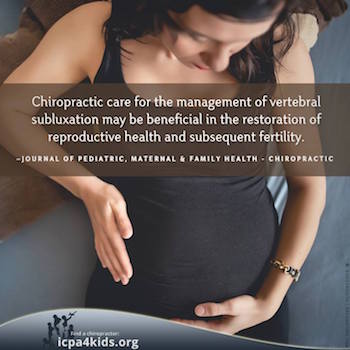According to the British Medical Journal, “One in six couples have an unwanted delay in conception.” Research indicates that women ages 35 to 39 conceive spontaneously at half the rate of women ages 19 to 26.
Due to mainstream media, people often believe that their inability to conceive is “normal” and strictly a result of their increased age, when in reality there are many other factors that contribute to fertility challenges. The medical model of health instills the belief in mothers that the best solution is to take fertility drugs or undergo fertilization procedures. This route of intervention is not the only way to resolve fertility challenges.
The effectiveness of chiropractic care is revealed in a case study of a 23-year old female who underwent chiropractic care to improve her overall health, in the hope that she may ultimately be able to have a child. At the time of her physical exam there was a six-week history of numbness and tingling in her left foot, and within a month the temporary bouts of numbness included both of her legs and feet.
Chiropractic examination revealed that the woman’s spine showed signs of subluxation. This condition occurs when spinal movement is restricted or spinal bones (vertebrae) become slightly misaligned. The brain and spinal cord (central nervous system) relay information (in the form of electrical signals) to every tissue, organ and cell, allowing your body to function optimally. The information sent from the central nervous system is transmitted to every tissue, organ and cell via millions of nerves, extending from the spinal cord, coordinating every function of your body. When the spine, which protects the spinal cord, becomes subluxated or misaligned, it interferes with the information flow between the brain and body (i.e. nervous system and cells) jeopardizing your body’s natural ability to function normally and repair itself, including the reproductive system. Chiropractors are the only professionals trained in the management of vertebral subluxations. Chiropractic care may be beneficial in the restoration of reproductive health and subsequent fertility.
Back to the case study; the 23 year old patient had her first natural menstrual cycle 3 ½ months into care and discovered she was pregnant 4 ½ months after initiation of chiropractic care. This study concluded, “Marked resolution of the patient’s signs and symptoms was obtained concomitant with a reduction in subluxation findings at multiple levels.”
A study released in 2006 also suggests that chiropractic care may correct some cases of infertility. The report followed two women who were unable to ovulate due to Polycystic Ovary Syndrome. The women both underwent chiropractic care.
According to the report, prior to chiropractic care both women scored a 10 out of 10 on a standard assessment for menstrual irregularity. These findings demonstrate that the women were unable to ovulate. Following chiropractic care, both patients rated 0 out of 10 on the scale indicating complete recovery.
Chiropractic care may also help fertility challenges by providing natural pain relief, which often goes hand in hand with a reduction in pain medication. Conception followed by a miscarriage in the early days of pregnancy is common. The concern is that external chemicals may be contributing to these miscarriages. Many women know to avoid prescription medication when trying to conceive, but mistakenly believe that over-the-counter medications are safe. For example, non-steroidal anti-inflammatory drugs (NSAIDs), such as aspirin, dramatically increase the risk of an early miscarriage, according to a report in the British Medical Journal. A wide range of other medications and illegal drugs are linked with fertility problems. This is true not only for mom, but also for dad. For instance, marijuana use is associated with lowered sperm production.


